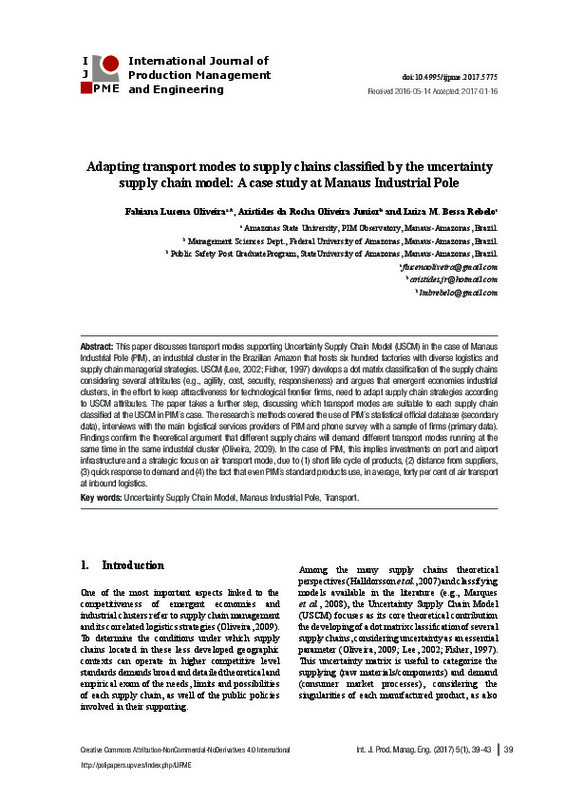JavaScript is disabled for your browser. Some features of this site may not work without it.
Buscar en RiuNet
Listar
Mi cuenta
Estadísticas
Ayuda RiuNet
Admin. UPV
Adapting transport modes to supply chains classified by the uncertainty supply chain model: A case study at Manaus Industrial Pole
Mostrar el registro sencillo del ítem
Ficheros en el ítem
| dc.contributor.author | Oliveira, Fabiana Lucena
|
es_ES |
| dc.contributor.author | Oliveira Junior, Aristides da Rocha
|
es_ES |
| dc.contributor.author | Bessa Rebelo, Luiza M.
|
es_ES |
| dc.date.accessioned | 2017-04-18T11:57:16Z | |
| dc.date.available | 2017-04-18T11:57:16Z | |
| dc.date.issued | 2017-01-31 | |
| dc.identifier.issn | 2340-5317 | |
| dc.identifier.uri | http://hdl.handle.net/10251/79742 | |
| dc.description.abstract | [EN] This paper discusses transport modes supporting Uncertainty Supply Chain Model (USCM) in the case of Manaus Industrial Pole (PIM), an industrial cluster in the Brazilian Amazon that hosts six hundred factories with diverse logistics and supply chain managerial strategies. USCM (Lee, 2002; Fisher, 1997)develops a dot matrix classification of the supply chains considering several attributes (e.g., agility, cost, security, responsiveness) and argues that emergent economies industrial clusters, in the effort to keep attractiveness for technological frontier firms, need to adapt supply chain strategies according to USCM attributes. The paper takes a further step, discussing which transport modes are suitable to each supply chain classified at the USCM in PIM´s case. The research´s methods covered the use of PIM´s statistical official database (secondary data), interviews with the main logistical services providers of PIM and phone survey with a sample of firms (primary data). Findings confirm the theoretical argument that different supply chains will demand different transport modes running at the same time in the same industrial cluster (Oliveira, 2009). In the case of PIM, this implies investments on port and airport infrastructure and a strategic focus on air transport mode, due to (1) short life cycle of products, (2) distance from suppliers, (3) quick response to demand and (4) the fact that even PIM´s standard products use, in average, forty per cent of air transport at inbound logistics. | es_ES |
| dc.language | Inglés | es_ES |
| dc.publisher | Universitat Politècnica de València | |
| dc.relation.ispartof | International Journal of Production Management and Engineering | |
| dc.rights | Reconocimiento - No comercial - Sin obra derivada (by-nc-nd) | es_ES |
| dc.subject | Uncertainty supply chain model | es_ES |
| dc.subject | Manaus industrial pole | es_ES |
| dc.subject | Transport | es_ES |
| dc.title | Adapting transport modes to supply chains classified by the uncertainty supply chain model: A case study at Manaus Industrial Pole | es_ES |
| dc.type | Artículo | es_ES |
| dc.date.updated | 2017-04-18T11:49:53Z | |
| dc.identifier.doi | 10.4995/ijpme.2017.5775 | |
| dc.rights.accessRights | Abierto | es_ES |
| dc.description.bibliographicCitation | Oliveira, FL.; Oliveira Junior, ADR.; Bessa Rebelo, LM. (2017). Adapting transport modes to supply chains classified by the uncertainty supply chain model: A case study at Manaus Industrial Pole. International Journal of Production Management and Engineering. 5(1):39-43. https://doi.org/10.4995/ijpme.2017.5775 | es_ES |
| dc.description.accrualMethod | SWORD | es_ES |
| dc.relation.publisherversion | https://doi.org/10.4995/ijpme.2017.5775 | es_ES |
| dc.description.upvformatpinicio | 39 | es_ES |
| dc.description.upvformatpfin | 43 | es_ES |
| dc.type.version | info:eu-repo/semantics/publishedVersion | es_ES |
| dc.description.volume | 5 | |
| dc.description.issue | 1 | |
| dc.identifier.eissn | 2340-4876 |








